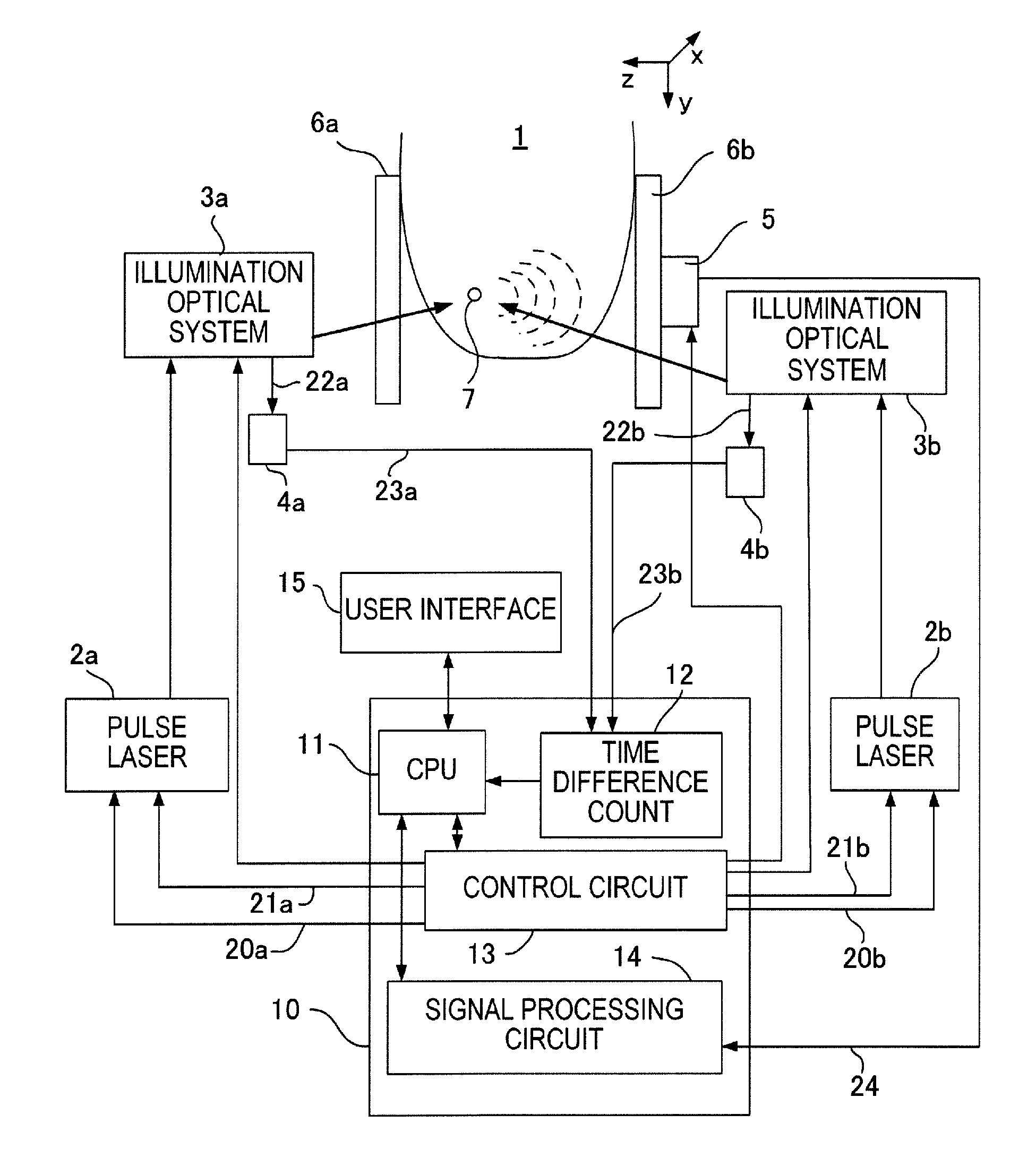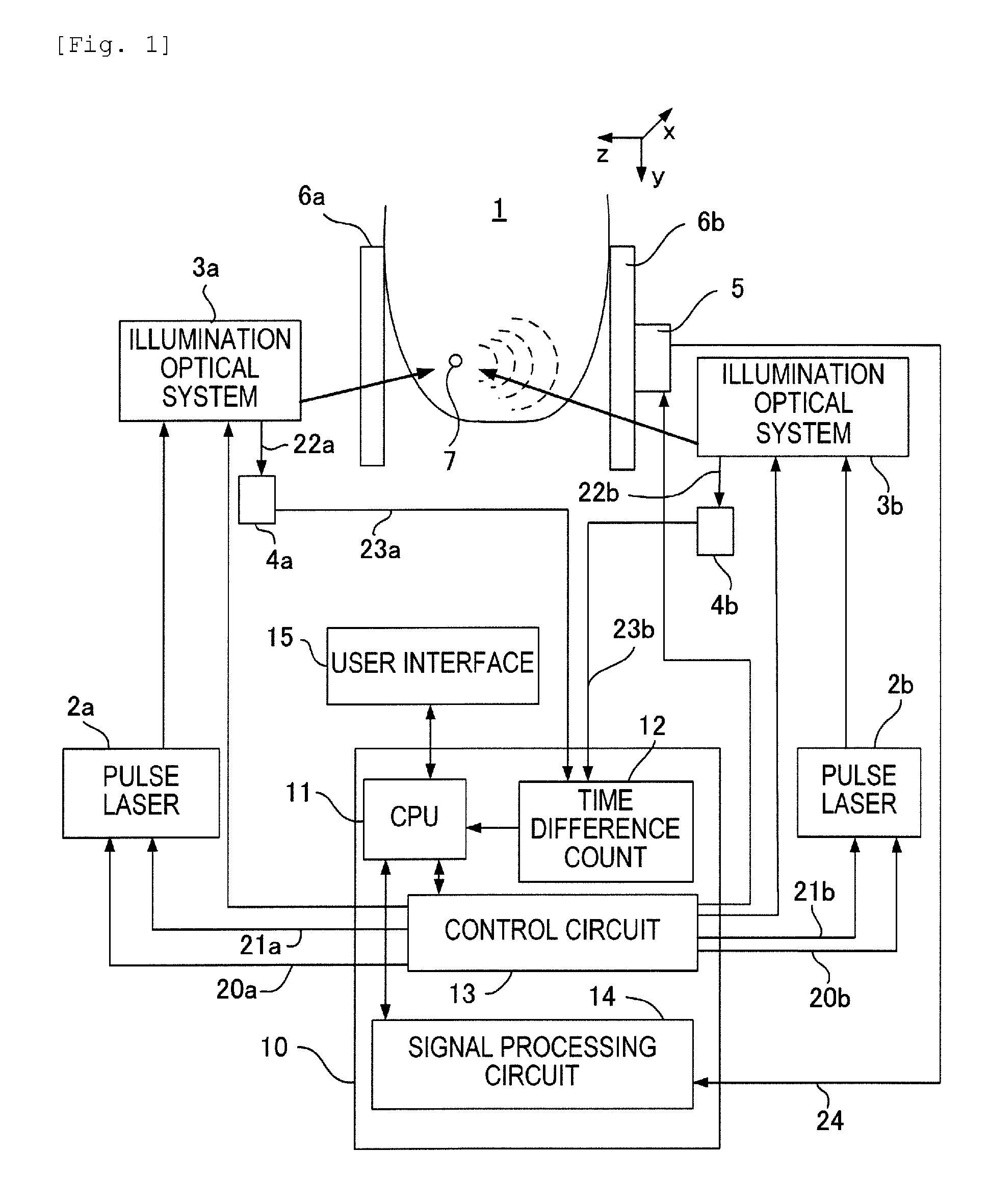Measuring apparatus
a technology of measuring apparatus and measuring cylinder, which is applied in the field of measuring cylinders, can solve the problems of irradiation timings that may actually be discrepant, individual differences in pulsed light sources, and age-related deterioration, so as to reduce the discrepancy of emission timings, improve diagnostic image quality, and reduce the effect of artifacts
- Summary
- Abstract
- Description
- Claims
- Application Information
AI Technical Summary
Benefits of technology
Problems solved by technology
Method used
Image
Examples
first example
(General Configuration)
[0030]FIG. 1 is a block diagram depicting a first example of a measuring apparatus according to the present invention. In FIG. 1, 1 is a subject and a part of a body of a subject person. For example, if the measuring apparatus is used for the diagnosis of breast cancer, a breast is the subject. This measuring apparatus has a plurality of (two in this example) pulse laser sources 2a and 2b. Hereafter the pulse laser source 2a is also referred to as a first laser source, and the pulse laser source 2b as a second laser source. The pulse laser sources 2a and 2b are light sources for generating pulsed light, and are constituted by a YAG laser, a titanium-sapphire laser or the like. The pulse laser sources 2a and 2b have a flash lamp as a means for exciting the laser medium inside the pulse laser source. Each pulse laser source 2a and 2b has a Q switch. The flash lamp and the Q switch can be externally controlled electrically. If the Q switch is turned ON after turn...
second example
[0089]Second example of the present invention will be described next. A difference of Second example from first example is that a timing is also adjusted when measuring a subject. This example is for supporting a case when the fluctuation of the emission timing is gradually increasing when pulsed light is irradiated onto the subject, due to the temperature rise inside the pulse laser source.
[0090]Description on the block diagram in FIG. 1 and the control signal generation circuit 30 in FIG. 3 is omitted since both are already described in first example.
[0091]An operation flow of a measuring apparatus of this example will now be described with reference to FIG. 7. Description on step S30 to step S33, which is the same as step S1 to step S4 in first example, is omitted. It is assumed that the values in the previous measurement are held in the register 31 in the control circuit 13 when step S33 is completed. Description on step S34 to step S36, which is the same as step S6 to step S8 i...
third example
[0095]Third example of the present invention will be described next. A difference of third example from first example is that not only a timing of turning ON the flash lamp of the pulse laser sources, but also the interval from the turning ON the flash lamp to the oscillation of the Q switch is changed. By changing the interval from the lighting of the flash lamp to the oscillation of the Q switch, the quantity of the energy to be stored in the laser medium inside the pulse laser source is changed. This example allows to adjust the pulsed light to be irradiated onto the subject 1. For example, in FIG. 1, a strong photoacoustic wave may be generated from the surface of the plate member 6b in some cases when the quantity of pulsed light from the illumination optical system 3b is too strong. In this case, the photoacoustic wave, not from the subject 1, wraps around the probe 5, which may generate an artifact. A case of decreasing the quantity of pulsed light from the illumination optic...
PUM
 Login to View More
Login to View More Abstract
Description
Claims
Application Information
 Login to View More
Login to View More - R&D
- Intellectual Property
- Life Sciences
- Materials
- Tech Scout
- Unparalleled Data Quality
- Higher Quality Content
- 60% Fewer Hallucinations
Browse by: Latest US Patents, China's latest patents, Technical Efficacy Thesaurus, Application Domain, Technology Topic, Popular Technical Reports.
© 2025 PatSnap. All rights reserved.Legal|Privacy policy|Modern Slavery Act Transparency Statement|Sitemap|About US| Contact US: help@patsnap.com



